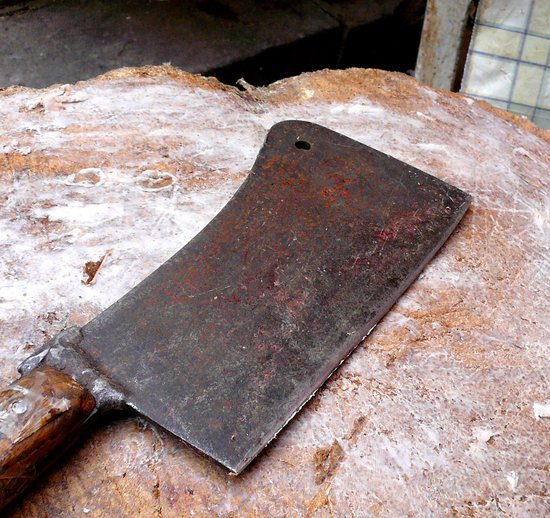If you're not going to eat the beast whole, you've got to cut it up. Hence the cleaver, the boning knife, the scimitar, the snicker-snee. Before your food gets anywhere near the heat of a grill, griddle or rotisserie, it's at the receiving end of a blade. (The one on the butcher block was at the Capo market in in Palermo, Siciliy, where it had recently been used to dismember the carcass of a lamb; the other is Martin Islas cutting tajarin pasta at Cascina Spinasse on Capitol Hill.)
Italians have a thing for knives, and with good reason. Arrotini, they call them, moletas, knife-sharpeners and scissors-grinders. They are descendents of early tradesmen in the remote Val Rendena in northern Dolomites.
 By what accident of fate did this obscure craft flourish in these villages? By what accident of history did its practitioners venture forth at the end of the 19th century, for the big cities of North America? Yet come they did, honing the knives earlier immigrants (German butchers, English cooks, French chefs). Eventually, they brought their families over, too, and set out across the continent. According to an article in today's New York Times,
By what accident of fate did this obscure craft flourish in these villages? By what accident of history did its practitioners venture forth at the end of the 19th century, for the big cities of North America? Yet come they did, honing the knives earlier immigrants (German butchers, English cooks, French chefs). Eventually, they brought their families over, too, and set out across the continent. According to an article in today's New York Times,
The Binellis set up knife-sharpening businesses in Detroit, Chicago and Medford, Mass.; the Maganzinis ended up in and around Boston. The Povinellis set up shop in Buffalo and ventured to North and South Carolina and Arizona; offshoots of the Nella family went to Toronto and Vancouver, as well as Long Island, Seattle and West Jordan, Utah.Indeed, from its facility in SoDo, Nella services scores of local restaurants with knives, slicers and grinders. The Canadian branch of the company even won a contract to supply bayonets to the Canadian Army. The knives they supply to restaurant kitchens in Seattle are utilitarian, not the elegantly tooled French and German blades you'd see at Sur la Table. This is plastic-handled equipment designed to withstand the assault of inexpert users and the abuse of the Auto-Chlor dishwasher. Probably not strong enough to dispatch a whole lamb.

Leave a comment